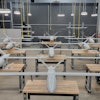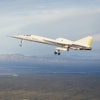Inside the NASA Goddard Space Flight Center in Maryland is a massive clean room that houses a valuable component of the James Webb Telescope — the world’s most powerful space telescope that will replace the Hubble Space Telescope.
Set for launch in 2018, the James Webb Telescope has been in the works since the 1990s, originally under the name Next Generation Space Telescope. The construction has spanned almost a decade and is still underway.
A number of the telescope’s instruments are already complete, Forbes reports, including the near infrared camera (the telescope’s main camera) and the brand-new sunshield. The five-layer sunshield —about the size of a tennis court — will block the sun’s heat altogether and eliminate the need for a cooling system.
The latest tool to be completed is the telescope’s defining feature: a 21.3-foot primary mirror.
With about six times the surface area of the Hubble, the Webb will be able to see and study the universe’s earliest stars and galaxies. Additionally, the Webb will have more sensitive equipment and will orbit around the second Lagrange point, which is about 1 million miles from Earth compared with Hubble’s 375 miles.
The primary mirror comprises 18 hexagonal mirrors that are each about 4 feet wide and coated in gold. Although the mirrors are made out of relatively lightweight beryllium, each still weighs nearly 90 pounds.
To accurately place each of these mirrors only millimeters apart, NASA used a robotic arm maneuvered by engineers.
With this mirror complete, the engineers will turn their attention to cryogenic tests of the Integrated Science Instrument Module, which houses the aforementioned camera as well as detectors and spectrographs. Those two pieces, as well as the sunshield, will be connected later this year.
What do you think of this massive space telescope? Do you think it will rival the Hubble’s legacy? Comment below or tweet @MNetKatie.
(All images courtesy of NASA/Goddard Space Flight Center)






















